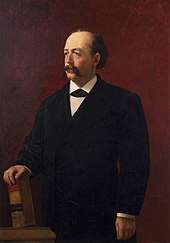Cushman Kellogg Davis
Cushman Kellogg Davis (June 16, 1838 – November 27, 1900) was an American Republican politician who served as the seventh Governor of Minnesota and as a U.S. Senator from Minnesota.
Cushman Davis | |
|---|---|
 | |
| United States Senator from Minnesota | |
| In office March 4, 1887 – November 27, 1900 | |
| Preceded by | Samuel J. R. McMillan |
| Succeeded by | Charles A. Towne |
| 7th Governor of Minnesota | |
| In office January 7, 1874 – January 7, 1876 | |
| Lieutenant | Alphonso Barto |
| Preceded by | Horace Austin |
| Succeeded by | John S. Pillsbury |
| Member of the Minnesota House of Representatives | |
| In office 1867–1868 | |
| Personal details | |
| Born | Cushman Kellogg Davis June 16, 1838 Henderson, New York |
| Died | November 27, 1900 (aged 62) Saint Paul, Minnesota |
| Political party | Republican |
| Spouse(s) | Laura Bowman (1st), Anna Malcom Agnew Fox (2nd) |
| Alma mater | Carroll College University of Michigan |
| Military service | |
| Branch/service | Union Army |
| Years of service | 1861–1864 |
| Rank | First Lieutenant |
| Unit | 28th Wisconsin Volunteer Infantry Regiment |
| Battles/wars | American Civil War |
Early life and American Civil War
Davis was born in Henderson, New York to Horatio N. Davis and Clarissa Cushman. His family moved to Wisconsin Territory before he was a year old (his father went on to serve as a member of the Wisconsin State Senate several different times). Cushman went to school at Carroll College and then the University of Michigan, graduating in 1857. Admitted to the bar in 1860, he soon after found himself serving in the American Civil War in the 28th Wisconsin Volunteer Infantry Regiment, serving first as a lieutenant in charge of Company B of this volunteer regiment. He was in action in the western campaigns, then in 1864 as an aide to General Willis A. Gorman.[1][2]

Political career
Davis returned home in 1864 due to poor health. He relocated to St. Paul, Minnesota due to its reputation as a health resort and began to pursue a legal and political career. He was elected to the Minnesota State House of Representatives from 1867 to 1868 and was appointed as the United States District Attorney from 1868 to 1873. He resigned his position to run as the Republican candidate for Minnesota governor and won. During his term, he established a state board of railway commissioners, revised the state constitution to allow women to vote on school matters and hold elected office, and also provided assistance to farmers affected by a locust plague. He served one term from 1874 to 1876 and declined to be re-nominated for a second.[2][3][4]
Return to legal career and second political career
Returning to his legal career, Davis successfully defended Judge Sherman Page in his 1878 impeachment trial. He also formed a partnership with Frank B. Kellogg and Cordenio Severance. In 1887, he was elected to the United States Senate. He would serve in the 50th, 51st, 52nd, 53rd, 54th, 55th, and 56th United States Congresses, from 1887 to 1900. He was involved with legislation related to pensions and the construction of the Soo Locks. Beginning in 1897 he was the chair of the Senate Foreign Relations Committee and was closely involved with the sequence of events leading to the Spanish–American War. He was also present at the talks for the Treaty of Paris which ended the war.[1][2]
Personal life
Davis married Laura Bowman in 1862. He remarried Anna Malcom Agnew Fox at some point in the 1880s.[3]
Honors
Davis was elected a member of the American Antiquarian Society in 1894.[5]
Death
Davis died while still in office in 1900. He is buried at Arlington National Cemetery in Virginia.
See also
- List of United States Congress members who died in office (1900–49)
References
- Chisholm 1911.
- Stevens, Hiram Fairchild (1904). History of the Bench and Bar of Minnesota. Minneapolis and Saint Paul: Legal Publishing and Engraving Company. pp. 95–101.
- "Davis, Cushman Kellogg — Legislator Record". Minnesota Legislative Reference Library.
- "Cushman Kellogg Davis". National Governors Association.
- American Antiquarian Society Members Directory
Attribution Chisholm, Hugh, ed. (1911). . Encyclopædia Britannica (11th ed.). Cambridge University Press.
Further reading
- Kreuter, Kent; Kreuter, Gretchen (Fall 1969). "The Presidency or Nothing: Cushman K. Davis and the Campaign of 1896" (PDF). Minnesota History. 41 (7): 301–316. JSTOR 20178039.
External links
- United States Congress. "Cushman Kellogg Davis (id: D000095)". Biographical Directory of the United States Congress.
- Memorial addresses on the life and character of Cushman Kellogg Davis, late a representative from Minnesota delivered in the House of Representatives and Senate frontispiece 1901
| Party political offices | ||
|---|---|---|
| Preceded by Horace Austin |
Republican nominee for Governor of Minnesota 1873 |
Succeeded by John S. Pillsbury |
| Political offices | ||
| Preceded by Horace Austin |
Governor of Minnesota 1874–1876 |
Succeeded by John S. Pillsbury |
| U.S. Senate | ||
| Preceded by Samuel J. R. McMillan |
U.S. senator (Class 1) from Minnesota 1887–1900 Served alongside: Dwight M. Sabin, William D. Washburn Knute Nelson |
Succeeded by Charles A. Towne |

